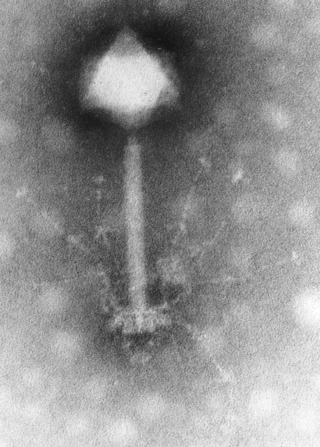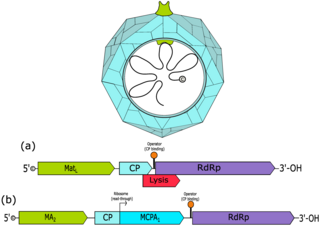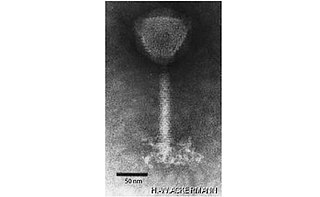
Myoviridae is a family of bacteriophages in the order Caudovirales. Bacteria and archaea serve as natural hosts. There are 625 species in this family, assigned to eight subfamilies and 217 genera.

Podoviridae is a family of bacteriophage in the order Caudovirales often associated with T-7 like phages. There are 130 species in this family, assigned to 3 subfamilies and 52 genera. This family is characterized by having very short, noncontractile tails. Podoviradae are largely understudied and most new isolates are of the phicbkviruses genus, a group of giant viruses that appear to be Caulobacter specific.

Comovirinae is a subfamily of viruses in the order Picornavirales, in the family Secoviridae; its genera were formerly classified in the family Comoviridae. Plants serve as natural hosts. There are 62 species in this subfamily, assigned to 3 genera.

Fiersviridae is a family of positive-strand RNA viruses which infect prokaryotes. Bacteria serve as the natural host. They are small viruses with linear, positive-sense, single-stranded RNA genomes that encode four proteins. All phages of this family require bacterial pili to attach to and infect cells. The family has 185 genera, most discovered by metagenomics. In 2020, the family was renamed from Leviviridae to its current name.
Fuselloviridae is a family of viruses. Sulfolobus species, specifically shibatae, solfataricus, and islandicus, serve as natural hosts. There are two genera and nine species in the family. The Fuselloviridae are ubiquitous in high-temperature (≥70 °C), acidic hot springs around the world.

Betaflexiviridae is a family of viruses in the order Tymovirales. Plants and fungi serve as natural hosts. There are 108 species in this family, assigned to 13 genera in two subfamilies. Diseases associated with this family include mosaic and ringspot symptoms.

Autographiviridae is a family of viruses in the order Caudovirales. Bacteria serve as natural hosts. There are 373 species in this family, assigned to 9 subfamilies and 133 genera.
Picovirinae is a subfamily of viruses in the order Caudovirales, in the family Salasmaviridae. Bacteria serve as natural hosts. There are two genera and seven species in this subfamily.

Ampullaviridae is a family of viruses that infect archaea of the genus Acidianus. Only one genus in this family has been described, Bottigliavirus, which contains three species. The name of the family and genus is derived from the Latin word for bottle, ampulla, due to the virions having the shape of a bottle. The family was first described during an investigation of the microbial flora of hot springs in Italy.

Okubovirus is a genus of viruses in the order Caudovirales, in the family Herelleviridae, in the subfamily Spounavirinae. Bacteria serve as natural hosts. There are two species in this genus.

Schizotequatrovirus is a genus of viruses in the order Caudovirales, in the family Myoviridae, in the subfamily Tevenvirinae. Bacteria serve as natural hosts. There are three species in this genus.
Tequatrovirus is a genus of viruses in the order Caudovirales, in the family Myoviridae, in the subfamily Tevenvirinae. Gram-negative bacteria serve as the natural host, with transmission achieved through passive diffusion. There are 75 species in this genus.
Peduovirinae is a subfamily of viruses in the order Caudovirales, in the family Myoviridae. Bacteria serve as natural hosts. There are 76 species in this subfamily, assigned to 31 genera.
Spounavirinae is a subfamily of viruses in the order Caudovirales, in the family Herelleviridae. Bacteria serve as natural hosts. There are currently five species in this subfamily, divided among 2 genera.
Myohalovirus is a genus of viruses in the order Caudovirales, in the family Myoviridae. Bacteria and archaea serve as natural hosts. There are three species in this genus.
Salasvirus is a genus of viruses in the order Caudovirales, in the family Salasmaviridae, in the subfamily Picovirinae. Bacteria serve as natural hosts. There are four species in this genus.
Tristromaviridae is a family of viruses. Archaea of the genera Thermoproteus and Pyrobaculum serve as natural hosts. Tristromaviridae is the sole family in the order Primavirales. There are two genera and three species in the family.
Deltalipothrixvirus is a genus of viruses in the family Lipothrixviridae. Archaea acidianus serve as natural hosts. Two species are assigned to the genus.

Gammalipothrixvirus is a genus of viruses in the family Lipothrixviridae. Archaea acidianus serve as natural hosts. There is only one species in this genus: Acidianus filamentous virus 1.
Bullavirinae is a subfamily of viruses in the family Microviridae. Enterobacteria serve as natural hosts. There are 14 species in this subfamily, organized into three genera.











